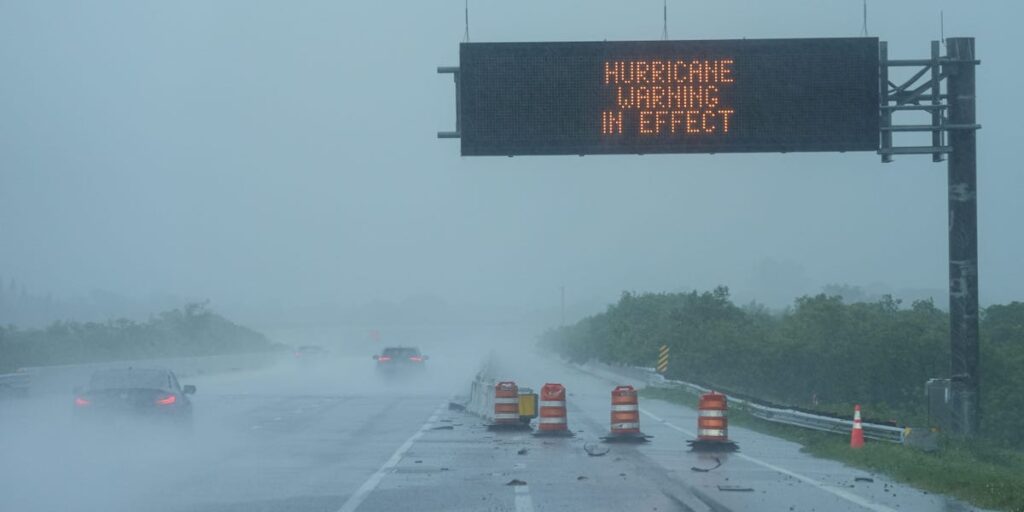- As Hurricane Milton hit, TikTok was filled with live streams from people in Florida.
- But even though there were plenty of live videos, it was hard to follow for breaking news.
- TikTok also amplified controversy, like with a woman who refused to evacuate her waterfront house.
As Hurricane Milton approached Florida this week, my TikTok “For You” Page was full of videos of people battening down windows, piling up sandbags, and livestreaming their surroundings as the weather grew more ominous by the hour. As night fell and power outages swept the coast, I watched live streams of palm trees swaying in the dark rain.
On one hand, this live video was exactly the kind of thing that I wanted to see. And it’s a dream for some tech moguls — as Elon Musk has said about X — to host on-the-ground citizen journalists streaming unvarnished live video.
But it was also utterly confusing. Scrolling through the live streams, I wasn’t sure if they were filmed in the direct path of the storm or somewhere else in Florida. Were these pre-recorded? Or filmed during another hurricane? Or were they truly live? What, exactly, was I looking at here? Regardless, I couldn’t look away.
Reporting live from a hurricane has been a staple of news since before Dan Rather’s famous soaked-trenchcoat broadcasts. (The modern version would be Anderson Cooper getting nailed in the face with flying debris Wednesday night on CNN.) It’s a visceral human experience to be in awe of extreme weather.
TikTok amplified controversial characters
But there was another modern element happening with the TikTok coverage — a weird, ugly theme that TikTok uniquely has seemed to encourage: the viral villain.
Like “couch guy,” “West Elm Caleb,” or the “Womblands” messy breakup, TikTok is good at creating a deluge of negative focus on characters. It’s slightly different from the classic idea of the “main character of the day” on old Twitter since the algorithmic nature of the TikTok FYP strips away context.
And indeed, TikTok found controversy for Hurricane Milton. A woman posted a series of videos earlier this week of her large home, saying she wouldn’t leave even though she was in a mandatory evacuation zone near the water. She said, “My husband built this house commercial … it’s residential, but it was built commercial-grade. It’s solid concrete.”
The videos went viral, and she became the “villain” of the day. (She turned off comments for her more recent videos that showed that she made it through the hurricane safely; BI has reached out for comment.)
Having seen the destruction of Hurricane Helene just weeks ago and the devastating flooding in North Carolina, people were primed for outrage at Floridians who ignored evacuation orders.
There was also outrage on other platforms about people who didn’t evacuate, like controversial memoirist Caroline Calloway, who Instagram-storied her way through the storm. On the streaming platform Kick, a man attempted to ride out the storm on an air mattress in exchange for $70,000 offered by streamer Adin Ross, who had recently interviewed Donald Trump. The streamer eventually gave up, but Ross gave him $10,000 for the effort.
If you feel like you lost several IQ points reading that last paragraph, you are not alone.
Max Read wrote about these villainous hurricane streamers in his newsletter:
None of these people are particularly informative or helpful; they’re barely even entertaining. All these videos — which are generally what surfaces to the top when you search “Milton” on TikTok or Twitter — are new recombinations of the same kinds of awful reality-TV motifs that now dominate every social network: endurance challenges to unclear end; wealth porn and self-aggrandizement; and, most importantly, mental illness as a form of entertainment. It’s just that, instead of watching them because you’re bored, you watch them because they’re what comes up when you’re looking for information about an ongoing news event on social media.
TikTok had the best live video on the ground in Florida, but no good way to make sense of it
It’s certainly true that the attention economy rewards attention-seeking trolls and bad behavior, and loves a good dogpile. This, I think, is a problem with the way that TikTok served the content. There were many videos showing people’s experiences preparing for and riding out a historic storm — but only the most anger-inducing people went viral.
Normally, the “Live” section is a mishmash of ASMR creators, randos, and people trying to hustle for digital coins. But Wednesday night, there actually was a lot of live, interesting, compelling news footage of an important event happening in a specific location. That was far different from on X, which previously used to be the best place to get live news.
The problem was that TikTok’s warping effect always leads us toward these specific outrageous stories. Instead of some sort of curated live feed of storm coverage, I saw multiple videos discussing two or three people who had decided against all good judgment to stay in their homes.
TikTok isn’t meant for live, breaking news, and I imagine it probably doesn’t want to be. Turns out, platforms have realized that’s a bad business to be in! But at this moment, I see how TikTok could — with some tweaks in the algorithm — be useful for the sort of coverage we’d otherwise get from TV news.
Read the full article here
















